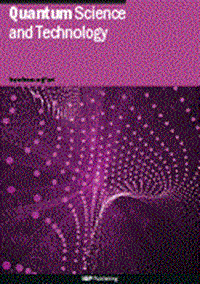振动动力学的量子算法:单线态裂变太阳能电池设计案例研究
IF 5
2区 物理与天体物理
Q1 PHYSICS, MULTIDISCIPLINARY
引用次数: 0
摘要
核运动和电子态之间的振动相互作用对光化学的精确建模至关重要。然而,精确模拟全量子非绝热动力学通常是昂贵的经典方法超出小系统。在这项工作中,我们提出了一种基于乘积公式的量子算法,用于模拟真实空间中一般振动哈密顿量下的时间演化,能够处理任意数量的电子态和振动模式。我们开发了超过两个电子态的振动哈密顿子的第一个颤振方案,并引入了一系列优化技术,用于乘积公式中每个片段的幂次,从而实现了非常低的成本。为了证明实际意义,我们概述了将我们的算法集成到设计更高效的单线态裂变有机太阳能电池的材料发现管道中的原理证明。我们利用二阶Trotter积公式估计,在蒽二聚体中,激子输运的6态21模模型需要154个量子比特和2.76 × 106个Toffoli门,传输100 fs。而描述蒽-富勒烯界面电荷转移的4态246模式模型需要1053个量子比特和2.66 × 107个Toffoli门。本文章由计算机程序翻译,如有差异,请以英文原文为准。
Quantum algorithm for vibronic dynamics: case study on singlet fission solar cell design
Vibronic interactions between nuclear motion and electronic states are critical for the accurate modeling of photochemistry. However, accurate simulations of fully quantum non-adiabatic dynamics are often prohibitively expensive for classical methods beyond small systems. In this work, we present a quantum algorithm based on product formulas for simulating time evolution under a general vibronic Hamiltonian in real space, capable of handling an arbitrary number of electronic states and vibrational modes. We develop the first trotterization scheme for vibronic Hamiltonians beyond two electronic states and introduce an array of optimization techniques for the exponentiation of each fragment in the product formula, resulting in a remarkably low cost of implementation. To demonstrate practical relevance, we outline a proof-of-principle integration of our algorithm into a materials discovery pipeline for designing more efficient singlet fission-based organic solar cells. We estimate that 100 fs of propagation using a second-order Trotter product formula for a 6-state, 21-mode model of exciton transport at an anthracene dimer requires 154 qubits and 2.76 × 106 Toffoli gates. While a 4-state, 246-mode model describing charge transfer at an anthracene-fullerene interface requires 1053 qubits and 2.66 × 107 Toffoli gates.
求助全文
通过发布文献求助,成功后即可免费获取论文全文。
去求助
来源期刊

Quantum Science and Technology
Materials Science-Materials Science (miscellaneous)
CiteScore
11.20
自引率
3.00%
发文量
133
期刊介绍:
Driven by advances in technology and experimental capability, the last decade has seen the emergence of quantum technology: a new praxis for controlling the quantum world. It is now possible to engineer complex, multi-component systems that merge the once distinct fields of quantum optics and condensed matter physics.
Quantum Science and Technology is a new multidisciplinary, electronic-only journal, devoted to publishing research of the highest quality and impact covering theoretical and experimental advances in the fundamental science and application of all quantum-enabled technologies.
 求助内容:
求助内容: 应助结果提醒方式:
应助结果提醒方式:


